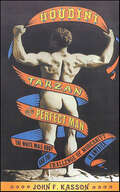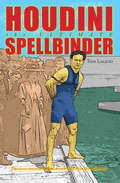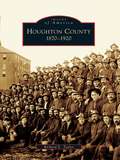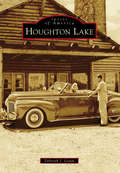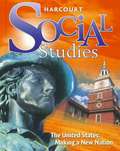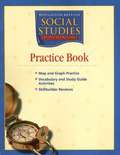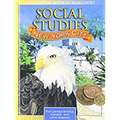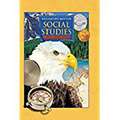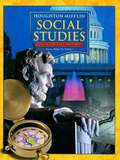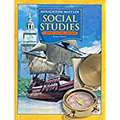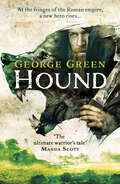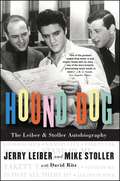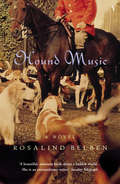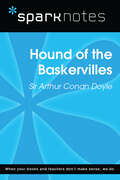- Table View
- List View
Hottest Muscle Cars
by Bob WoodsThe book is about the beginning of America's love for muscle cars, and why they are still loved today.
Houdini, Tarzan, and the Perfect Man: The White Male Body and the Challenge of Modernity in America
by John F. KassonA remarkable new work from one of our premier historiansIn his exciting new book, John F. Kasson examines the signs of crisis in American life a century ago, signs that new forces of modernity were affecting men's sense of who and what they really were.When the Prussian-born Eugene Sandow, an international vaudeville star and bodybuilder, toured the United States in the 1890s, Florenz Ziegfeld cannily presented him as the "Perfect Man," representing both an ancient ideal of manhood and a modern commodity extolling self-development and self-fulfillment. Then, when Edgar Rice Burroughs's Tarzan swung down a vine into the public eye in 1912, the fantasy of a perfect white Anglo-Saxon male was taken further, escaping the confines of civilization but reasserting its values, beating his chest and bellowing his triumph to the world. With Harry Houdini, the dream of escape was literally embodied in spectacular performances in which he triumphed over every kind of threat to masculine integrity -- bondage, imprisonment, insanity, and death. Kasson's liberally illustrated and persuasively argued study analyzes the themes linking these figures and places them in their rich historical and cultural context. Concern with the white male body -- with exhibiting it and with the perils to it --reached a climax in World War I, he suggests, and continues with us today.
Houdini: The Ultimate Spellbinder
by Tom LalickiOriginally published as: SPELLBINDER: The Life of Harry Houdini.He was born Ehrich Weiss but, at an early age, he chose another name for himself. He wanted a name to suit his career of magic and entertainment and he chose a name that paid homage to one of the legendary magicians of all time: Robert Houdin. His illusions and escapes were more astonishing and more challenging than anyone had ever done before and he eclipsed the names of all other magicians as his fame reached around the world, made him famous and made him the most famous illusionist ever.Houdini disappeared through brick walls. He escaped from straitjackets and then straitjackets immersed in water. He performed escapes in public places and from jail cells in major cities--and the crowds flocked to his performances.Tom Lalicki tells Houdini's story with a fascinating mix of text and images, revealing the facts and juxtaposing them with startling images of a master entertainer performing masterfully and mysteriously, mesmerizing his audiences and mystifying experts with his skill and his invention.
Houghton County: 1870-1920
by Richard E. Taylor"Go West, young man . . ." When Horace Greeley made his famous statement in the pages of Harper's Weekly, he was not referring to the goldfields of the late-1840s California, he was speaking of Michigan's western Upper Peninsula. In the mid- to late 1840s, Michigan's copper resources were rediscovered by state geologist Douglass Houghton, setting off a mining boom rivaled only by the gold rush of 1849. The richest copper and silver ores, and even some gold, were found in the mines of Houghton County. Famous mines such as "Old Reliable," the Quincy mine, and the Calumet and Hecla mines gave up billions of tons of pure native copper and millions of dollars to eastern investors for over 100 years. Railroads, steamship lines, and eventually trolley lines served Houghton County, offering connection to the outside world. Between 1850 and 1920, mining companies attracted immigrants from Cornwall, England; Germany; Italy; Finland; Ireland; the Austro-Hungarian empire; and French Canada. The area was a true melting pot. Although this era of prosperity saw the rise of labor unions, the period culminated in the tragic and unsuccessful strike of 1913.
Houghton Lake
by Deborah I. GouinNestled among northern Michigan's pine trees in Roscommon County is the state's largest inland lake, Houghton Lake. Lumbermen made use of its 20,044 acres to move timber. They banked logs on the lake, the headwaters of the Muskegon River, during the winter cutting season and drove them downriver in the spring to southwestern lumber yards. As Houghton Lake's reputation for good fishing grew, visitors came to try their luck. By the mid-20th century, Houghton Lake became one of the most popular destinations in Michigan. Now, the area is known for its bars, resorts, and winter festival Tip-Up Town USA. Water sports, summer cottages, and nightlife still attract thousands of visitors from Lower Michigan and surrounding states today.
Houghton Mifflin Harcourt Social Studies: The United States, Making A New Nation
by Harcourt School PublishersHave you ever wondered how the United States of America came to be and how its past affects you today? You will read about what it was like to live during the time when important events in our nation took place. You will learn about some of the people who took part in those events and about the place where each event happened.
Houghton Mifflin History Social Science (California Edition)
by Douglas Carnine Anita T. Robinson Kenneth R. Curtis Carlos E. CortesThis California edition of Houghton Mifflin History Social Science contains Introduction to World History, Early Civilizations of Southwest Asia, Ancient Africa, Ancient Asian and American Civilizations, The Roots of Western Ideas, and The World of Ancient Rome.
Houghton Mifflin History-Social Science: California Studies
by Herman J. Viola Sarah Witham Bednarz Mark C. Schug Charles S. White Cheryl Jennings Carlos E. CortesThe major sections of this book are units. Units are divided into chapters, and each opens with a vocabulary preview. The lessons in this book have two parts: core and extend that bring social studies to life and help you meet your state's standards.
Houghton Mifflin Social Studies (Grade 4, Georgia Edition)
by Herman J. Viola Sarah Witham Bednarz Mark C. Schug Charles S. White Cheryl Jennings Carlos E. CortésThe history of the United States is an exciting story about people, places, and events. In this book, you'll read about brave actions, tough decisions, and great ideas, past and present. As you study, you'll be achieving Georgia's standards. These are learning goals to help you understand who has made a difference in your nation's history and why the events of the past are so important. The standards also help you develop geography and thinking skills--and understand personal finance.
Houghton Mifflin Social Studies (Oklahoma Edition)
by Houghton MifflinYour book includes many features to help you be a successful reader. Every chapter and lesson helps you with social studies terms. You'll build your vocabulary through strategies you're learning in language arts.
Houghton Mifflin Social Studies 5: United States Civil War to Today (Tennessee Edition)
by Herman J. Viola Sarah Witham Bednarz Mark C. Schug Charles S. White Cheryl Jennings Carlos E. CortesThis book contains topics on Our Land and Its Government, The Civil War, Transforming a Nation, The Early Twentieth Century, Modern America and Linking to the Present.
Houghton Mifflin Social Studies Tennessee: United States History (Level #4)
by Herman J. Viola Sarah Witham Bednarz Mark C. Schug Charles S. White Cheryl Jennings Carlos E. CortésThis book covers the culture, economics, geography, governance & civics, history, individuals, groups and interactions of Tennessee.
Houghton Mifflin Social Studies: Canada and Latin America
by Houghton MifflinHoughton Mifflin Social Studies: Canada and Latin America builds on and reinforces historical and political content about the United States included in the grade 4 social studies program.
Houghton Mifflin Social Studies: Communities (Grade 2, Tennessee Edition)
by Herman J. Viola Sarah Witham Bednarz Mark C. Schug Charles S. White Cheryl Jennings Carlos E. CortésLearn about Tennessee, its people, economics, geography and history.
Houghton Mifflin Social Studies: States and Regions Practice Book
by Houghton MifflinThis practice book contains unit lessons on: The Land of the United States, The East, The South, The Midwest, The West, and Connections to Our World.
Houghton Mifflin Social Studies: The United States, Canada, and Latin America (New York City Edition)
by Herman J. Viola Sarah Witham Bednarz Mark C. Schug Charles S. White Cheryl Jennings Carlos E. CortésThe United States, Canada, and Latin America, inter alia, contains Interactive lesson summaries of Geography, Early Civilizations in the Americas, European Exploration, Creating a New Nation, A Time of Change, Growth and Expansion, Geography and Early People, Spanish and Portuguese Colonies, Modern Latin America, Geography and First Peoples, Colonial Canada, Modern Canada, Government in the Americas, and The Western Hemisphere Today.
Houghton Mifflin Social Studies: United States History (Level #5)
by Herman J. Viola Maryellen Vogt Dolores Beltran Sarah BednarzThis book includes many features to help you be a successful reader which include comprehension support, reading skills, reading strategies and vocabulary support.
Houghton Mifflin Social Studies: United States History, Civil War to Today
by Herman J. Viola Sarah Witham Bednarz Mark C. Schug Charles S. White Cheryl Jennings Carlos E. CortésHistory textbook about the past 150 years in the USA.
Houghton Mifflin Social Studies: United States History, Early Years
by Herman J. Viola Sarah Witham Bednarz Mark C. Schug Charles S. White Cheryl Jennings Carlos E. CortesThis Social Studies book contains topics on: Our Land and First People, Exploration and Settlement, The English Colonies, The American Revolution, The New Nation, The Civil War, and Linking to Today.
Houghton Mifflin Social Studies: United States History, Early Years (5th Grade Louisiana Edition)
by Herman J. Viola Sarah Witham Bednarz Carlos E. Cortés [et al.]Houghton Mifflin Social Studies Early Years, covers the early peoples history, their lives, culture, their activities and the events that took place.
Houghton Mifflin Social Studies: United States History, Early Years (California Edition)
by Herman J. Viola Sarah Witham Bednarz Mark C. Schug Charles S. White Cheryl Jennings Carlos E. CortésThe history of United States is told in this textbook through the research of historians, through quotations, letters, songs, and voices from the past, and through images, fine art, and data--a rich resource for learning.
Hound
by George GreenAt the fringes of the Roman Empire, a new hero rises. &“A strong sense of history as well as myth . . . An impressive first novel.&” —The Guardian When Leary, a Roman charioteer, is shipwrecked at the edge of the known world, he fears for his life. Whispers had reached Rome of blue-painted demons in the trees of this gods-forsaken land beyond Brittania: Ireland. But the people of this country welcome him into the court of King Conor, which throngs with heroes boasting, drinking and telling stories of their exploits in battle. There he meets a young boy, an outsider whose birth is shrouded in mystery: Cuchulainn, who will one day become Ireland&’s greatest warrior. Cuchulainn&’s exploits become the stuff of legend as he grows. But when the armies of the vengeful Queen Maeve gather at the gates of Emain Macha, Cuchullain must face both his greatest challenge and his dark destiny . . . Retold as never before, this is a thrilling, timeless tale of heroism and friendship, of love and betrayal, of war and poetry. This is the story of Cuchullain, the Hound of Ulster, perfect for fans of Conn Iggulden, Bernard Cornwell and Giles Kristian. &“The ultimate warrior&’s tale.&” —Manda Scott, author of Boudica
Hound Dog: The Leiber & Stoller Autobiography
by Jerry Leiber Mike StollerThe hitmakers behind Elvis Presley&’s &“Hound Dog&” and &“Jailhouse Rock&” recount their rise to songwriting stardom while authoring the classic American R&B sound of countless chart-topping singles.In 1950 a couple of rhythm and blues–loving teenagers named Jerry Leiber and Mike Stoller met for the first time. They discovered their mutual affection for R&B and, as Jerry and Mike put it in this fascinating autobiography, began an argument that has been going on for over fifty years with no resolution in sight. Leiber and Stoller were still in their teens when they started working with some of the pioneers of rock and roll, writing such hits as "Hound Dog," which eventually became a #1 record for Elvis Presley. Jerry and Mike became the King&’s favorite songwriters, giving him "Jailhouse Rock" and other #1 songs. Their string of hits with the Coasters, including "Yakety Yak," "Poison Ivy," and "Charlie Brown," is a part of rock &’n&’ roll history. They founded their own music label and introduced novel instrumentation into their hits for the Drifters and Ben E. King, including "On Broadway" and "Stand by Me." They worked with everyone from Phil Spector to Burt Bacharach and Peggy Lee. Their smash musical Smokey Joe&’s Café became the longest-running musical revue in Broadway history. Lively, colorful, and irreverent, Hound Dog describes how two youngsters with an insatiable love of good old American R&B created the soundtrack for a generation.
Hound Music
by Rosalind BelbenTo George Lupus, Master of the Quarr Hounds, the fox is a 'gentleman'. The four children all hunt, and are tremendously keen. But Dorothy Lupus dislikes the sport that has been her beloved husband's passion. When a tragedy occurs, Dorothy finds she can't bear the proximity of the kennels across the park. Roguish, Rakish, Harebell, Arcady and Argot, Striver, Decorous, Fearless, Snowmaid... Dorothy wishes never to hear their hullabaloo again. She is adamant...
Hound of the Baskervilles (SparkNotes Literature Guide Series)
by SparkNotesHound of the Baskervilles (SparkNotes Literature Guide) by Sir Arthur Conan Doyle Making the reading experience fun! Created by Harvard students for students everywhere, SparkNotes is a new breed of study guide: smarter, better, faster.Geared to what today's students need to know, SparkNotes provides:chapter-by-chapter analysis explanations of key themes, motifs, and symbols a review quiz and essay topics Lively and accessible, these guides are perfect for late-night studying and writing papers.

